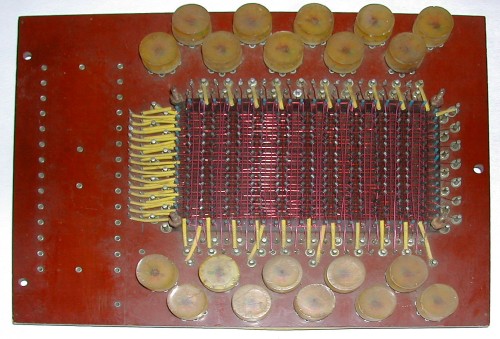Core Memory (1)
| Home > Browse Our Collection > Peripherals > Core Memory > Core Memory (1) |
|
The attached photographs show a very early example of core memory. This board measures 10 inches (254mm) by 7.5 inches (191mm).
Any help in dating this circuit board would be greatly appreciated.
Please email collection@computinghistory.org.uk with any information.
Sven Koeppel of www.technikum29.de has commented as follows:
"it's quite difficult to identify the origins of your core memory. I think the year of manufacture is about 1960-1963.
Either your memory was a former part of an exploited core memory (in this case your memory is very old) or it is a small part from a desk calculator, an accounting machine or something like that." Dr Edo H Dooijes, Curator, Computermuseum University of Amsterdam, www.science.uva.nl/museum has commented as follows:
"The 20*14 bits memory plane must have been used in a first- generation, probably British computer, using valves (vacuum tubes).
The thinner red wires are the bit-selection wires, the thicker wire threaded through all of the cores (as far as I can see it) is the sense line. The selection wires are driven through the small transformers alongside the core matrix. The primary windings of these transformers are in the anode circuits of pentode valves (one for each selection wire). To tell more (or more accurately) about the unit, I need to be able to hold it in my hands, and to test the wiring layout electrically (using a common multimeter)." Eric Luiijf MSc. Principal Consultant TNO Physics and Electronics Laboratory, The Netherlands. kindly writes:
"A first assessment by the professor I did my thesis with, one of the Dutch computer pioneers, assessed this as a first experimental handmade probe to test the function of core memory. No idea where it could come from.
I came to the same conclusion "date 50's", "large cores", "handmade, limited series board". We have some boards which have been developed at our premises and look (only) a little bit more developed than this one. If I get more inputs, I let you know"
This exhibit has a reference ID of CH3434. Please quote this reference ID in any communication with the Centre for Computing History. |
|












